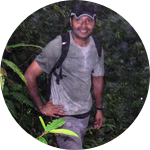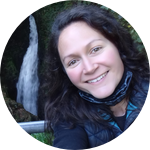About This Project
Natural forest regeneration is one solution for the climate and biodiversity crises. Traditional gardening in Papua New Guinea is a cycle of planting, harvesting and fallow periods where the ecosystem recovers. We want to set up long-term forest monitoring plots to provide information about forest dynamics and carbon services in eastern PNG. We will train local people to collect data, supporting their careers as future conservationists and local leaders in sustainable land-use decisions.
Ask the Scientists
Join The DiscussionWhat is the context of this research?
Indigenous people are the most effective forest protectors. Supporting them to meet their aspirations and live on land traditionally means reconciling their food security with forest clearance for small-scale gardens. To help shift focus from gardening as a destructive force into an integral part of the forest ecosystem, we need to investigate re-growth in traditional rotational agriculture.
Forest health is an important factor in the role forest plays as a solution to climate breakdown. Few studies have been done looking at regeneration in PNG forests, and none specifically on lowland gardens. We need to know how regeneration occurs with gardening practices for conservationists and local people to decide how to use their land for sustainable gardening.
What is the significance of this project?
Rainforests in PNG are a mosaic of old growth forest, gardens and fallow gardens that are left for 15-20 years, reflecting traditional forest farming. A long-term monitoring project of these gardens over time will allow us to determine forest regrowth, wildlife return, carbon sequestration and overall forest health. By identifying strengths and weaknesses of local gardening methods, people can make changes to improve carbon sequestration, forest health and food security. This can be replicated in other community forests.
We will provide training to our local collaborators in research methods, allowing them to further their careers as researchers and conservationists. This project will merge science with local forest knowledge in an empowering research collaboration.
What are the goals of the project?
To investigate how forest health increases over fallow periods of rotational agriculture, we will set up two 1 hectare plots in 3 different forest garden types: Mature forest, gardens that have been fallow for 4-6 years and gardens that have been fallow for 12-15 years.
In each plot we will select 10-20 trees to measure the size and calculate the carbon content. Where present we will select trees of endangered/vulnerable species, such as Pterocarpus indicus (a Rosewood). We will measure other diversity through mammal, bird and insect sampling.
Plots will be selected, GPS located and sampled by local landowners and research assistants under the supervision of a consultant with expertise in forest health monitoring. The plots will be re-sampled every 2-3 years to see changes in health
Budget
Costs are for setting up the plots and taking baseline measurements of forest health during year one of the project. It will take 2 weeks in the field for seeking FPIC (Free, Prior Informed Consent) from landowners, training and measuring.
Re-sampling will be every 2-3 years. Resampling costs will reduce each year as local people take ownership of data collection and external advice is needed less.
Field research collaborator - to collect quality data, take initial measurements and train local people, we will hire a team member from a field research station in PNG. This centre has well-established forest health and carbon monitoring plots in Madang. Their knowledge of PNG rainforests and culture is integral to providing effective and appropriate training.
Local forest guides - residents of local area to assist with data collection.
Local village hosts - who cook and host researcher in the village.
Equipment - using tech applications for data collection.
Endorsed by
 Project Timeline
Project Timeline
After the plots are established in year one, they will be revisited every 2-3 years. Each time, the same data will be collected and a research report will be produced. Plot sampling will continue for a minimum of 8 years, after which the forest in the 4-6 year fallow plots will represent the initial 12-15 year old fallow plots. This will allow a continuum of data from 4 year fallow to 23 year old forest growth.
Jan 12, 2021
Project Launched
Apr 30, 2021
Use existing biodiversity data collected from two conservation plots in 2020 to get initial estimates of species diversity in un-gardened areas. This milestone is desk-based.
Jun 30, 2021
Complete the FPIC process with landowners so that we may use plots over many years. Mapping of plot locations also carried out during these field trips and consultations.
Jun 30, 2021
Field selection of plots in the three area types: mature forest, 4-6 year fallow and 12-15 year fallow
Jul 31, 2021
Use of local knowledge and forest guides to identify and GPS locate endangered and vulnerable species of tree in the areas to focus the study on.
Meet the Team
Clifford Yaee
I am the Forest Project Coordinator at Cool Earth, based in Alotau, Papua New Guinea.
I am passionate in this area of scientific research because only through research will we enhance skills and knowledge. It also gives understanding to certain problems around the importance of forests for carbon storage and for local food security. This experiment can help to advocate solutions to the issues through awareness and education for local people who can manage forests sustainably.
I have gained a degree from the University of Goroka in PNG, majoring in Biology, in which research is one of the major courses that was taught, enhancing my ability to do research in the field better. I also did my research on amphibians as my final year thesis paper which has been recognized by the International Community of Amphibians. And mostly I have been engaged in research work with Cool Earth organization as my employer which gives me confidence in doing research.
Most importantly I also did a research on carbon sequestration. This research included carbon calculations, focusing on endangered rosewood trees. The research provides a base to build this project from. Local gardeners have background understand to the research, and a good relationship with me as the lead researcher.
All of this has given me the confidence and experience so that I am the most suitable for this research, and with my team can produce an effective result.
Ali Skeats
Inspired by animals and the countryside since I was a child, I've followed a career path into conservation of the world's most valuable ecosystems and species. I've been lucky to meet so many excellent conservationists and people whose aims are to live sustainably, whether in the city or remote Papua New Guinea.
I am a zoology graduate and my career doing field work surveys, teaching university students and providing conservation project management consultancy to NGOs means I am able to support Clifford's lead on this project.
Matt Proctor
I work for the nonprofit organisation Cool Earth in their Forest Impacts team, who monitor forest health indicators such as carbon stocks, biodiversity and canopy cover. We try to understand the forest where we work using a combination of remote sensing technologies and citizen science inputs.
Additional Information
To add to the Project Context, we would highly recommend reading Macqueen, D and Mayers, J (2020) Unseen Foresters: An assessment of approaches for wider recognition and spread of sustainable forest management by local communities, which has inspired this project.
From a total rural population of 3.4 billion, some 1.3 billion forest-dependent people live in forests as Indigenous Peoples or local communities (IPLCs). Good evidence suggests that when granted local control, IPLCs generally protect forests better than industrial scale companies do, and even better than many protected areas have. This assessment finds and describes approaches that could achieve wider recognition and spread of sustainable forest management (SFM) by IPLCs."
Project Backers
- 18Backers
- 6%Funded
- $361Total Donations
- $20.06Average Donation




